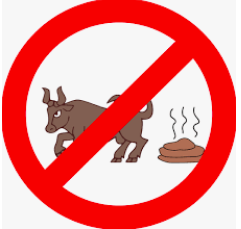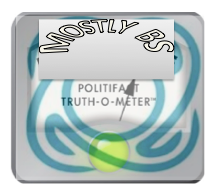An organization called Poynter Institute for Media (1) released a "Politifact" report in an attempt to verify the following bulls##t fact: “Drug overdose deaths decreased in 2018 for the first time in 30 years.” Their verdict?

Their verdict (L). Mine (R). Image: Politifact
There are a number of problems here. First, the concepts of "fact" and "politics" don't mesh all that well, especially these days. Second, In checking the facts of the claim Poynter itself screws up pretty badly. More on that later. Third, the author Julie Appleby uses a dubious source. You, of course, know who he is...

The Ubiquitous Andrew "Pellets" Kolodny. Not looking so great, but he keeps hopping from one interview to the next. Original Image: Flickr
POYNTER PROBLEMS AND KOLODNY'S NEW DIET
So is it correct to say “Drug overdose deaths decreased in 2018 for the first time in 30 years?" Technically maybe, but don't get fooled by the numbers, real or not. They have been used by politicians, bureaucrats, and assorted other miscreants to imply that "well-thought-out policy changes" that they so carefully orchestrated over the past decade, have finally turned the tides on the "opioid fentanyl crisis" and we are back on the trail to Shangri-La. Yay! We got control of the opioid epidemic by writing fewer prescriptions!

Image: Public Domain Vectors
Let's fact-check the fact-checkers...
"Did the death rate decline in 2018 as [a detective being interviewed] noted? Yes, but that’s not the whole story."
So far, so good.
"According to the Centers for Disease Control and Prevention, 67,367 people died of drug overdoses in 2018. That number exceeded the tally, based on the most recent data available, of those who died either in car wrecks or by firearms."
Are people really still saying this? As I've wondered in the past, what the hell do drug overdoses have to do with gun violence or car accidents? Nothing. This is just manipulative hyperbole. And this idiotic statement could just as easily be rewritten: "Those of you who fear guns or auto accidents can rest easy. The chances of dying from either are now lower than from drug overdoses," and be just as accurate.
"Two-thirds of those drug overdose deaths involved some type of opioid, including those given by prescription or those purchased illicitly, such as heroin."
Noooooo! Not this again. This stale, disingenuous statement implies that overdose deaths are caused by a more-or-less equal mixture of prescription drugs and street drugs. This is dead wrong, something recently reinforced by a new study in the Canadian Medical Association Journal, which shows that prescription opioid pills are responsible for 2% of all overdose deaths in British Columbia (2). Here's a similarly crafted statement which is just as accurate and misleading, and only a little more ridiculous:
"More than 68% of homicides in the US in 2018 involve firearms, knives, and Brussels sprouts."
"To combat [a growing number of opioid prescriptions], a growing number of prescribing recommendations have been issued by physician and hospital groups, aimed at reducing the number of pills per prescription and the total number of prescriptions. The overall prescribing rate fell to 51 prescriptions per 100 people by 2018, according to the CDC."
Wow! A 51% decrease in prescription pills over six years! How did that work out?
Not very well really...

Despite a marked decrease in prescriptions (L) the number of opioid overdose deaths soared (R). Sources: Pain News Network, National Institute on Drug Abuse. Nice work, folks.
DID ANYTHING GO RIGHT?
That depends on how you define "right." Note that in the graph on the right there is a small (4%) decrease in opioid overdose deaths from 2017-8.
“It looks like there's a light at the end of the tunnel...”
A. Kolodny, New York Times, 7/17/2019
"Brandeis University professor Andrew Kolodny said it was the first overall downtick in drug overdoses in 30 years, but he would parse it a bit for opioids, saying it was the first decline in 25 years."
Should you be thinking that we're making any progress here, forget it...

2019 erased (and then some) the "progress" of 2018. Source: CDC. And 2020 is expected to be worse.
This, of course, caused Kolodny to whip out a knife, fork, and napkin and eat his words:
"It is misleading to point to a slight reduction in 2018, when deaths went up again in 2019 and we remain at record-high levels of opioid deaths..."
A. Kolodny, Politifact, August 26, 2020
PROGRESS? NO. A LOAD OF CRAP? YES.
Whatever that tiny decrease is in 2018 means – if it's even real (3) – it's inconsequential. The "opioid epidemic" not only hasn't abated, but it's sure also gone a long way toward starting a fentanyl epidemic, and more recently, methamphetamine epidemic (see Meth Is Back Like Never Before. Blundering Opioid Policies Largely To Blame). It should be undeniably clear by now that restriction of opioid prescription medications has helped approximately no one, but hurt many (4).
Our verdict is identical to that of Amy Bohnert, associate professor at the University of Michigan:
"It’s disingenuous to pretend that was a huge win. As someone who does research on this, I would be reluctant to consider a change of that scale to be clearly a sign of a real change as opposed to random error."
So, let's close with the brand new ACSH TRUTH-O-METER. It reaches a different conclusion...

NOTES
(1) The Poynter Institute for Media Studies is a non-profit journalism school and research organization located in St. Petersburg, Florida. The school is the owner of the Tampa Bay Times newspaper and the International Fact-Checking Network. (Wikipedia)
(2) "Toxicology and prescribed medication histories among people experiencing fatal illicit drug overdose in British Columbia, Canada" by Crabtree, et. at., is a new paper in CMAJ that examines the cause of death of in a systematic, analytical manner – very different from that of the bungling by our CDC. I will be writing about how the authors pinned down the actual cause of death rather than simply counting drugs detected in overdose victims and adding them up. Smart work.
3) There are many possible explanations for the 4% decline, including a statistical blip, a change in counting methods, fake or manipulated data, etc. It could even be real. It doesn't really matter.
(4) I'm not, of course, just talking about addicts. I've written innumerable times about the appalling plight of pain patients who have been denied access to or forcibly withdrawn from the medications they need to function. The increase in suicides, as well as depression, insomnia, and other psychiatric conditions resulting from untreated or under treated pain has been documented by Pergolizzi Jr. and colleagues.




